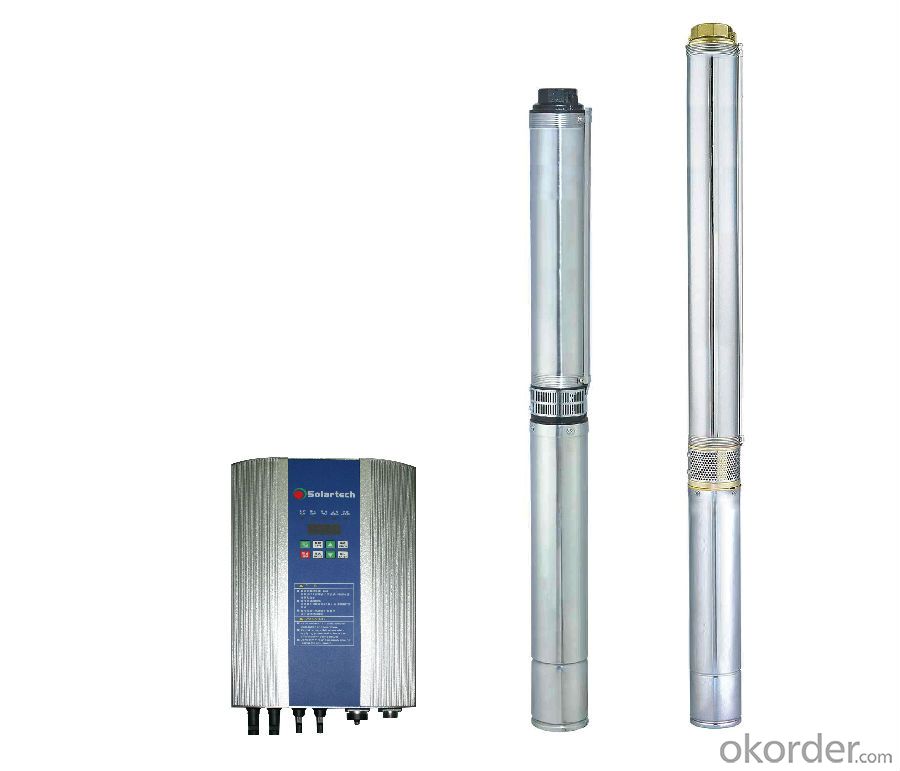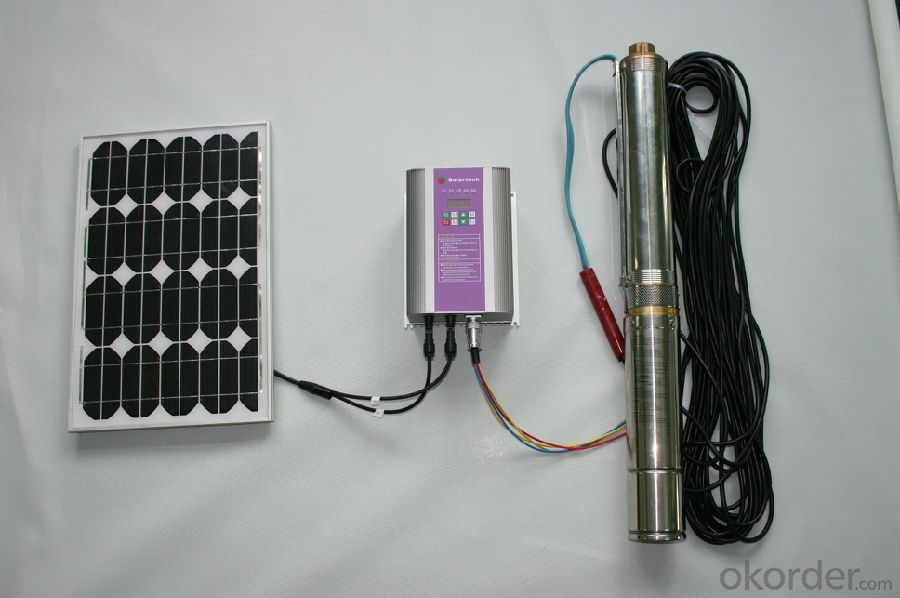Solar Water Pump Controller for Solar System
- Loading Port:
- Shekou
- Payment Terms:
- TT OR LC
- Min Order Qty:
- 20 unit
- Supply Capability:
- 800000 unit/month
OKorder Service Pledge
OKorder Financial Service
You Might Also Like
Products
Solar Pumping System can be applied to daily use (ground water), agricultural irrigation, forestry irrigation, desert control, pasture animal husbandry, water supply for islands, wastewater treatment engineering, and so on. Solar water pump System is dispensed with energy storing devices, and stores water instead of electricity. It improves the reliability of the device, at the same time, it lowers the construction and maintenance costs of the irrigation system dramatically.
In recent years, with the promotion of the utilization of new energy resources, Solar Pumping System is more and more used in municipal engineering, city centre squares, parks, tourist sites, resorts and hotels, the landscapes and fountain irrigation systems in the residential areas.
Technical Features
Optimization of Single Pump System
A single solar irrigation system consists of only one pump, a power -matched solar array and an inverter . The aim of optimization is to reduce the amount of PV modules as much as possible on the premise of filling the requirement of head and capacity. The rotational speed of pump is regulated according to the irradiation on the solar array; when the sunlight reaches its peak, the pump runs at the rated speed, and the output approaches the peak power of the solar array; when the sunlight is less abundant, the speed of pump varies bellow the range of the rated speed; when the speed as low as the capacity becomes zero, the solar pumping system stops working. So, there are big differences between solar irriation systems and traditional pumping systems in system design, and the system should be optimized according to the requirements of head, capacity, and local conditions of sunlight.
•Determine the optimal average daily operating time and the range of speed governing.
•Choose the optimal head and capacity of the pump.
•Determine the maximum power of PV modules, the best working voltage and method of connection.
Optimization of Multi-pump Systems:
There are several pumps in a multi-pump system. The pumps can be driven either by only one high-power inverter, or by several matching inverters. In the case of large capacity demand, the operation of the multi-pump system is more flexible. By switching solar arrays and pumps, all of the pumps run in MPPT mode when the sunlight is abundant, while some pumps will be shut down and all solar arrays supply power intensively for the rest running pumps when irradiation is weak. Based on the optimization of single pump system, the range of speed can be further optimized, and the photovoltaic(PV) pumping system always works with high efficiency.
Product Specifications
Model | Rated Power ( kW ) | Rated Voltage ( V ) | Head ( M ) | Daily Flow ( ㎥/ D ) |
PS370 | 0.37 | 220 | 20-47 | 20-1 |
PS550 | 0.55 | 220 | 15-70 | 40-1 |
PS750 | 0.75 | 220 | 6-81 | 100-1 |
PS1100 | 1.1 | 220 | 8-93 | 100-1 |
PS1500 | 1.5 | 220 | 7-128 | 130-1 |
PS2200 | 2.2 | 380 | 12-163 | 130-1 |
PS3000 | 3 | 380 | 9-187 | 250-10 |
PS4000 | 4 | 380 | 6-225 | 500-10 |
PS5500 | 5.5 | 380 | 10-172 | 500-20 |
PS7500 | 7.5 | 380 | 15-237 | 500-20 |
PS9200 | 9.2 | 380 | 20-140 | 500-40 |
PS11000 | 11 | 380 | 23-159 | 500-40 |
PS13000 | 13 | 380 | 27-189 | 500-40 |
PS15000 | 15 | 380 | 31-208 | 500-40 |
PS18500 | 18.5 | 380 | 39-143 | 500-100 |
PS22000 | 22 | 380 | 25-86 | 700-210 |
PS26000 | 26 | 380 | 30-105 | 700-210 |
PS30000 | 30 | 380 | 35-125 | 700-210 |
PS37000 | 37 | 380 | 40-150 | 700-210 |
PS45000 | 45 | 380 | 50-180 | 700-210 |
PS55000 | 55 | 380 | 65-200 | 700-210 |


- Q:Can a solar controller be used with solar panels that are connected to a solar street light?
- Solar panels connected to a solar street light can indeed utilize a solar controller. A solar controller, also referred to as a charge controller, plays a vital role in a solar power system by regulating the flow of electricity from the solar panels to the battery. This regulation prevents both overcharging and over-discharging. In the case of a solar street light, the solar panels generate electricity during the daytime and charge the battery through the assistance of the solar controller. The solar controller guarantees that the battery reaches its optimal capacity and shields it from potential damage due to overcharging. During nighttime, the solar controller efficiently utilizes the battery's power to illuminate the street light. Hence, a solar controller is a crucial component of a solar street light system, ensuring proper charging and effective utilization of solar energy.
- Q:Are there any safety features built into solar controllers?
- Solar controllers come with multiple safety features. One of the primary safety features is overcharge protection. The purpose of solar controllers is to prevent batteries from getting overcharged, which can result in damage or even explosions. The controller constantly monitors the battery voltage and adjusts the charging current to ensure optimal charging without any risk of overcharging. Another safety feature is reverse polarity protection. This particular feature safeguards the solar controller from any potential damage caused by accidentally reversing the battery or solar panel connections. It effectively prevents short-circuits or harm to the controller. Furthermore, many solar controllers incorporate over-discharge protection. This feature prevents excessive discharge of the battery, which can lead to reduced lifespan or irreversible damage. By continuously monitoring the battery voltage, the controller automatically disconnects the load when the voltage drops below a specific threshold. Moreover, certain solar controllers offer temperature compensation. This feature adjusts the charging voltage according to the battery's temperature. It guarantees proper charging regardless of the ambient temperature, thereby extending the battery's lifespan. In conclusion, solar controllers are equipped with a range of safety features to ensure the protection of batteries and the controller itself. These features contribute to the safe and efficient functioning of solar power systems.
- Q:Can a solar controller be used in a solar-powered cooling system?
- Yes, a solar controller can be used in a solar-powered cooling system. A solar controller helps regulate the flow of electricity between the solar panels and the cooling system, ensuring efficient operation and protecting the system from overcharging or damage.
- Q:Can a solar controller be used with solar-powered street lights?
- Yes, a solar controller can be used with solar-powered street lights. A solar controller is an essential component that helps regulate and control the charging and discharging of batteries in solar systems. In the case of solar-powered street lights, the solar controller helps optimize the charging from the solar panels and ensures the batteries are not overcharged or discharged excessively. It also provides other functionalities like dusk-to-dawn operation, dimming, and monitoring, making it compatible and necessary for the efficient operation of solar-powered street lights.
- Q:What are the common failure modes of a solar controller?
- Common failure modes of a solar controller include overcharging, undercharging, short-circuiting, overheating, and failure to properly regulate the flow of energy between the solar panels and the battery.
- Q:What is the maximum input current for a solar controller with an LCD display?
- The maximum input current for a solar controller with an LCD display would depend on the specific model and specifications of the controller. It is recommended to refer to the manufacturer's documentation or product specifications to determine the maximum input current for a particular solar controller with an LCD display.
- Q:Can a solar controller be used with a battery bank that is connected in parallel?
- Yes, a solar controller can be used with a battery bank that is connected in parallel. The solar controller regulates the charging process of the batteries by controlling the amount of current flowing from the solar panels to the batteries. Whether the batteries are connected in parallel or series, the solar controller will still be able to monitor and regulate the charging process effectively.
- Q:Can a solar controller be used with MPPT (Maximum Power Point Tracking) technology?
- Yes, a solar controller can be used with MPPT (Maximum Power Point Tracking) technology. In fact, MPPT is a feature of certain advanced solar controllers that allow them to extract maximum power from solar panels by adjusting the operating point to the most efficient level. This technology helps in maximizing the overall efficiency and performance of a solar system.
- Q:Can a solar controller be used with solar-powered indoor cooling systems?
- Yes, a solar controller can be used with solar-powered indoor cooling systems. The solar controller helps regulate and optimize the charging and discharging of the batteries used in the cooling system, ensuring efficient utilization of solar power.
- Q:What is the maximum input power that a solar controller can handle?
- The maximum input power that a solar controller can handle depends on the specific model and its technical specifications. Generally, solar controllers are designed to handle a wide range of input power levels to accommodate different solar panel configurations and sizes. The maximum input power that a solar controller can handle is typically stated in terms of the maximum solar panel wattage it can support. For example, a solar controller may be rated to handle a maximum input power of 300 watts or 600 watts. This means that it can effectively regulate and convert the energy generated by solar panels with a combined wattage of up to that specified power level. It is important to carefully choose a solar controller that can handle the maximum input power of your solar panel system to ensure optimal performance and prevent damage to the controller. Exceeding the maximum input power rating of a solar controller can lead to overheating, reduced efficiency, or even failure of the controller. When selecting a solar controller, it is recommended to consider the total wattage of the solar panels in your system and choose a controller that can comfortably handle that power level. It is also advisable to consult the manufacturer's specifications and guidelines for proper selection and installation of the solar controller to ensure compatibility and safety.
1. Manufacturer Overview |
|
|---|---|
| Location | |
| Year Established | |
| Annual Output Value | |
| Main Markets | |
| Company Certifications | |
2. Manufacturer Certificates |
|
|---|---|
| a) Certification Name | |
| Range | |
| Reference | |
| Validity Period | |
3. Manufacturer Capability |
|
|---|---|
| a)Trade Capacity | |
| Nearest Port | |
| Export Percentage | |
| No.of Employees in Trade Department | |
| Language Spoken: | |
| b)Factory Information | |
| Factory Size: | |
| No. of Production Lines | |
| Contract Manufacturing | |
| Product Price Range | |
Send your message to us
Solar Water Pump Controller for Solar System
- Loading Port:
- Shekou
- Payment Terms:
- TT OR LC
- Min Order Qty:
- 20 unit
- Supply Capability:
- 800000 unit/month
OKorder Service Pledge
OKorder Financial Service
Similar products
New products
Hot products
Hot Searches
Related keywords





























